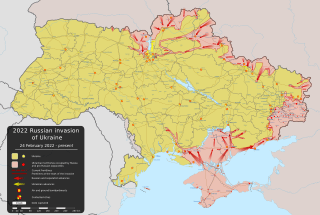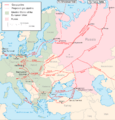Russia-Ukraine war facts for kids
Quick facts for kids Russo-Ukrainian War |
|||||||||
|---|---|---|---|---|---|---|---|---|---|
 The military situation as of 25 March 2022 Controlled by Ukraine
Occupied by Russia and pro-Russian forces
|
|||||||||
|
|||||||||
| Belligerents | |||||||||
|
Supported by
|
|||||||||
| Commanders and leaders | |||||||||
|
|
||||||||
| Casualties and losses | |||||||||
|
Civilian casualties
|
|||||||||
The Russo-Ukrainian War is an ongoing war between Russia (together with pro-Russian separatist forces) and Ukraine. It began in February 2014 following the Ukrainian Revolution of Dignity, and initially focused on the status of Crimea and parts of the Donbas, internationally recognised as part of Ukraine. The first eight years of the conflict included the Russian annexation of Crimea (2014) and the war in Donbas (2014–present) between Ukraine and Russian-backed separatists, as well as naval incidents, cyberwarfare, and political tensions. Following a Russian military build-up on the Russia–Ukraine border from late 2021, the conflict expanded significantly when Russia launched a "special operation" in Ukraine on 24 February 2022.
Following the Euromaidan protests and a revolution resulting in the removal of pro-Russian President Viktor Yanukovych in February 2014, pro-Russian unrest erupted in parts of Ukraine. Russian soldiers without insignia took control of strategic positions and infrastructure in the Ukrainian territory of Crimea, and seized the Crimean Parliament. Russia organized a widely-criticised referendum, whose outcome was for Crimea to join Russia. It then annexed Crimea. In April 2014, demonstrations by pro-Russian groups in the Donbas region of Ukraine escalated into a war between the Ukrainian military and Russian-backed separatists of the self-declared Donetsk and Luhansk republics.
In August 2014, unmarked Russian military vehicles crossed the border into the Donetsk republic. An undeclared war began between Ukrainian forces on one side, and separatists intermingled with Russian troops on the other, although Russia attempted to hide its involvement. The war settled into a static conflict, with repeated failed attempts at ceasefire. In 2015, the Minsk II agreements were signed by Russia and Ukraine, but a number of disputes prevented them being fully implemented. By 2019, 7% of Ukraine was classified by the Ukrainian government as temporarily occupied territories, while the Russian government had indirectly acknowledged the presence of its troops in Ukraine.
In 2021 and early 2022, there was a major Russian military build-up around Ukraine's borders. NATO accused Russia of planning an invasion, which it denied. Russian President Vladimir Putin criticized the enlargement of NATO as a threat to his country and demanded Ukraine be barred from ever joining the military alliance. He also expressed Russian irredentist views, questioned Ukraine's right to exist, and stated wrongfully that Ukraine was created by Soviet Russia. On 21 February 2022, Russia officially recognised the two self-proclaimed separatist states in the Donbas, and openly sent troops into the territories. Three days later, Russia invaded Ukraine. Much of the international community have condemned Russia for its actions in post-revolutionary Ukraine, accusing it of breaking international law and violating Ukrainian sovereignty. As a result, many countries implemented economic sanctions against Russia, Russian individuals, or companies.
Images for kids
-
Residents of Kyiv with Sich Battalion volunteers on 26 August 2014
-
Pro-Russian rebels in Donetsk in May 2015. Ukraine declared the Russia-backed separatist republics from eastern Ukraine to be terrorist organizations.
-
From left, Russian President Vladimir Putin, French President Emmanuel Macron, German Chancellor Angela Merkel and Ukrainian President Volodymyr Zelenskyy in Paris, France, December 2019
-
Ukrainian deputy prime minister Olha Stefanishyna with NATO secretary-general Jens Stoltenberg at a conference on 10 January 2022 regarding a potential Russian invasion
-
A U.S. intelligence assessment map and imagery on Russian military movement nearby the Ukrainian border, as on 3 December 2021. It assessed that Russia had deployed about 70,000 military personnel mostly about 100–200 kilometres (62–124 mi) from the Ukrainian border, with an assessment this could be increased to 175,000 personnel. Published by The Washington Post.
-
Peace march in Moscow, 21 September 2014
-
Pro-Russian supporters in Donetsk, 20 December 2014
-
Ukrainian refugees in Kraków protest against the war, 6 March 2022
See also
 In Spanish: Guerra ruso-ucraniana (2014-actualidad) para niños
In Spanish: Guerra ruso-ucraniana (2014-actualidad) para niños



















